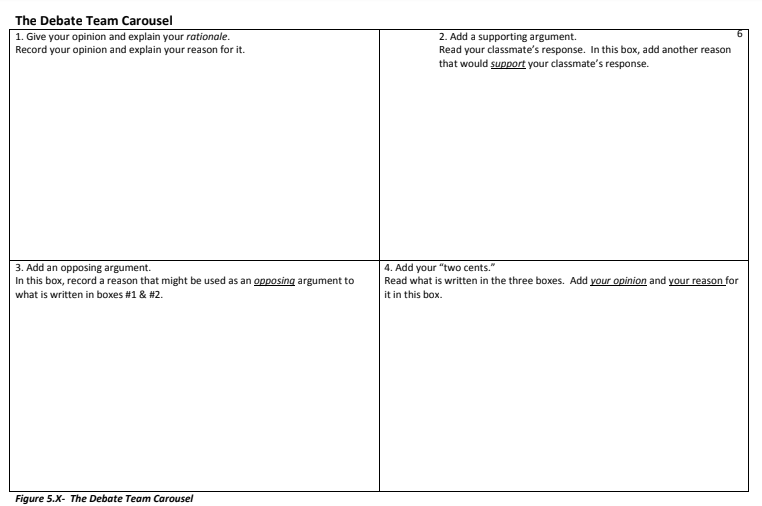Debate Team Carousel
What It Is
Debate Team Carousel is an activity in which students debate a position from various angles as prompted on a template. It allows students to see various aspects of an issue and consider what the opposing and supporting arguments for a certain position might be.
For example, an art teacher might ask, “Do you think Picasso was a more skilled painter before or after he discovered cubism?” In a Debate Team Carousel, this question would lend itself to requiring students to eventually analyze the loaded meaning of the term skill from different angles. This activity works with groups of four or more. Once all four boxes are filled in, the papers are returned to the original owner.
How It Works
- Create a prompt that requires students to use their judgment and the content presented to take a position. Record the prompt on the board or have it ready in your slides, so that students can read and refer to it while they complete all the boxes in the template.
- You will need a template for every student, so that all are responding at the same time. Ask all students to record their judgment and a rationale for what they believe in the first box.
- Ask all students to all pass their papers to the right, and read and add a supporting rationale that goes along with their peer’s judgment (even if they don’t agree).
- Ask all students to all pass their papers to the right, and read what is in both of their peers’ boxes and add something that might be used as an opposing rationale (whether they agree with the rationale or not).
- Ask all students to pass their papers to the right and add their own opinion, supporting it with their rationale, in the final box.
- Ask students to give the papers back to their original owners.
- Ask volunteers to share with the class some of the arguments for and against on their carousel forms.
How to Ensure Higher-Order Thinking
Debate Team Carousel lends itself to the analysis and evaluation of a topic. Be sure not to spell out the arguments for and against. Although the presentation of the content will usually take a slant toward one position or another, be careful not to explicitly tell students “these are the arguments for, and these are the arguments against.” Let the students come to their own judgments based on learned content.
Students will also have to consider and record what they believe might be supporting as well as opposing views. In doing so, they are required to analyze and evaluate learned material from different perspectives. Rationales for and against can be summarized when you debrief the activity in a whole group.

Source
Himmele P., and Himmele, W. Total Participation Techniques: Making Every Student an Active Learner. ASCD, 2017, pp.107-109.
